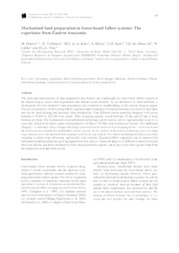Mechanized land preparation in forest-based fallow systems: the experience from eastern Amazonia.
Mechanized land preparation in forest-based fallow systems: the experience from eastern Amazonia.
Autoria: DENICH, M.; VIELHAUER, K.; KATO, M. do S. A.; BLOCK, A.; KATO, O. R.; SÁ, T. D. de A.; LÜCKE, W.; VLEK, P. L. G.
Resumo: The slash-and-burn practice of land preparation that farmers use traditionally in forest-based fallow systems in the humid tropics causes land degradation and human health hazards. As an alternative to slash-and-burn, a mechanized, fire-free method of land preparation was evaluated on smallholdings in the eastern Amazon region. The use of machinery for harvesting fallow vegetation and chopping it for mulch eliminates the need for hard labor and fire for land clearing and increases labor productivity. Four different tractor-propelled choppers with power demand of 50 kW to 122 kW were tested. Their chopping capacity varied between 4.5 Mg and 20 Mg of fresh biomass per hour. The mechanized chop-and-mulch technology can be used in fallow vegetation that is up to 12 years old, which in the study region corresponded to 20 Mg to 150 Mg fresh biomass per hectare. Two additional choppers ? a stationary silage chopper and a high-powered crawler tractor with a chopping device ? were also tested but both were not suitable for smallholder fallow systems. In the context of the mulch technology, new low-input crop varieties were screened and their response to fertilizer was studied. The mulch technology facilitates extended cropping, to plant crops off-season, and modify crop rotation. Degraded fallow vegetation can be improved by enrichment planting using fast-growing leguminous tree species. Financial analysis of different scenarios revealed that farm income and labor productivity from chop-and-mulch systems can be up to two times greater than from the traditional slash-and-burn system.
Ano de publicação: 2004
Tipo de publicação: Artigo de periódico
Unidade: Embrapa Amazônia Oriental
Observações
1 - Por padrão são exibidas publicações dos últimos 20 anos. Para encontrar publicações mais antigas, configure o filtro ano de publicação, colocando o ano a partir do qual você deseja encontrar publicações. O filtro está na coluna da esquerda na busca acima.
2 - Para ler algumas publicações da Embrapa (apenas as que estão em formato ePub), é necessário ter, no celular ou computador, um desses softwares gratuitos. Sistemas Android: Google Play Livros; IOS: iBooks; Windows e Linux: software Calibre.
Acesse outras publicações
Acesse a Base de Dados da Pesquisa Agropecuária (BDPA) para consultar o acervo completo das bibliotecas da Embrapa.

